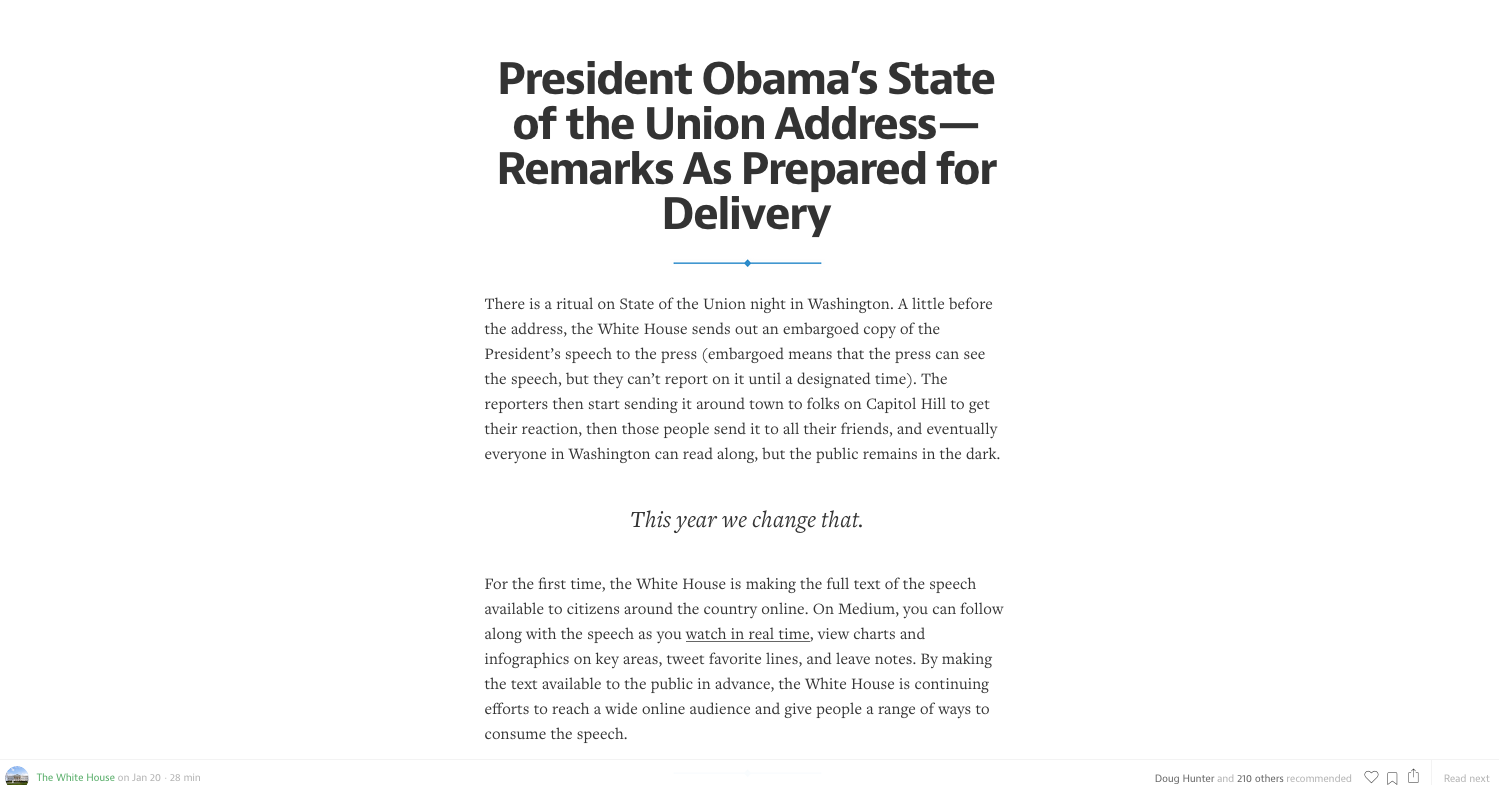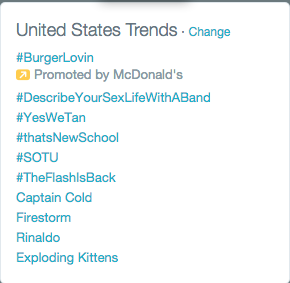I’ve admired the White House’s approach to social media for quite some time now. They get the importance of the platforms in communicating to a younger and/or targeted audience. Plus, they have managed to cut through what I imagine is a lot of red tape to have a stellar social media presence.
Tonight during the State of the Union, the White House’s social media team proved why they are the best of the best. While the SOTU is not a game (clearly), it is a live event. And as I watched the coverage unfold, I saw a lot of lessons learned that could apply to social media and sports. Here are six social media takeaways from the State of the Union coverage that can apply to our industry:
No. 1- Don’t listen to “that’s how it’s always been done”.
It seems that the agenda for the White House was simple: Reach as many people as possible. So in historic fashion, the White House released the SOTU ahead of time so viewers could read along. Not only that, but they released it on Medium:
I love that the White House throws out rules and previous protocols to do what is best for their objectives and goals. It didn’t matter where people consumed the information… they just wanted it in the hands of anyone and everyone. The move to release it ahead of time and on Medium was a smart one.
Lesson: Do things the right way, not the previous way. As the digital world evolves, we have to consider how, when and why our fans consume the information/content they do. Don’t be afraid to challenge the status quo on how you cover a game, press conference, draft, signing day, etc. In fact, take the time to think outside the box.
No. 2- Access doesn’t have to be intrusive.
Before the State of the Union, the White House shared pictures on their social media platforms that gave a peek behind the curtain, without being intrusive to President Obama as he prepped. Take a look:
President Obama's suiting up for the big speech. Watch at 9pm ET → http://t.co/NKU3ndKHOu #YesWeTan pic.twitter.com/l7EJZYVk9s
— The White House (@WhiteHouse) January 21, 2015
Lesson: I’ve talked a lot about access lately, but this is a great example of how access doesn’t always have to be intrusive to the team, players, coaches, etc. Even if you don’t have all the access you want, figure out how you can tell the behind-the-scenes story in creative fashion. Prep ahead of time. Take some artsy shots and add some strong copy. You’ll be good to go.
No. 3- Make it personal.
Before the State of the Union, the White House shared a picture of a hand written note from President Obama to America. This was much more personal than text on a website, Facebook post or tweet:
President Obama wrote you a note ahead of his State of the Union. Watch at 9pm ET: http://t.co/NKU3ndKHOu #SOTU pic.twitter.com/hqqmPz50T1
— The White House (@WhiteHouse) January 20, 2015
Lesson: Find a way to make your content personal for fans. Tap into creative ways to leverage the voice of your players and coaches. As this content proves, personal can be easy to execute.
No. 4- Have some fun.
Did you happen to see #YesWeTan trending? That wasn’t some secret teenage code, but from a tweet the White House sent (the one above with the suit):
The White House could easily be buttoned up and never have fun on social media, but they get the importance of being human and genuine. I love this example.
Lesson: I understand that sports are a lot less serious than what the White House covers, but I think this is a really great example of how to use humor strategically. We don’t have to be funny all the time. In fact, I think it can get old quickly. Find a way to leverage humor appropriately and at the right time. You’ll end up making a bigger splash, just like the White House did.
No. 5- Do the prep work.
With the State of the Union address comes statistics and a lot of information. To help make it all more consumable, the White House released some really sharp graphics:
"Instead, we’ve seen the fastest economic growth in over a decade, our deficits cut by two-thirds" —Obama #SOTU pic.twitter.com/dhrjyk1W1j
— The White House (@WhiteHouse) January 21, 2015
"I am sending…Congress a bold new plan to lower the cost of community college—to zero" —Obama #SOTU pic.twitter.com/p5IhRSLgsg
— The White House (@WhiteHouse) January 21, 2015
Clearly these graphics were not created in a split second; the White House team did a lot of prep beforehand to be ready for the live event.
Lesson: This is simple, but plan as much as you can. Create templates for games, signing day, draft day, etc. Think about how you will handle a loss/win, plan for the unexpected, define a look/feel, etc. You can eliminate a lot of stress and work during live events if you just do the prep work.
No. 6- Tap into emotions.
Throughout the address, the White House social media teamed sprinkled in imagery and photos that catered to people’s emotions. From a picture of President Obama as a young boy to pictures of our brave men and women that serve, they found a way to strike an emotional place:
"I said this because I had seen it in my own life, in a nation that gave someone like me a chance." —Obama #SOTU pic.twitter.com/ieOHHJxc7h
— The White House (@WhiteHouse) January 21, 2015
"We are humbled and grateful for your service.." —President Obama to our men and women in uniform #SOTU #WelcomeHome pic.twitter.com/edZvmKNdmh
— The White House (@WhiteHouse) January 21, 2015
These images are powerful, right? They tell a much better story than words alone.
Lesson: One of the key elements to people sharing content is high arousal (both positive and negative). And, high arousal goes hand-in-hand with sports. Emotions like awe, anxiety, anger, joy and surprise are all prevalent in the stories created on and off the field—tap into that emotion to create compelling content. If you want people to share, then trigger their emotions (and if you don’t believe me, read Contagious).
So, what stood out to you about the White House’s coverage of the State of the Union? Are there any other lessons we can apply here? Please share your thoughts below!
Thanks for reading!
0

These are great tips for any brand or field. I work on the academic side of a university (after 2.5 years in athletics), and I love taking “sports” ideas and finding ways to use them with academics.
Agree, Megan! The tips are very relevant across industries. Really appreciate your comment and you reading!